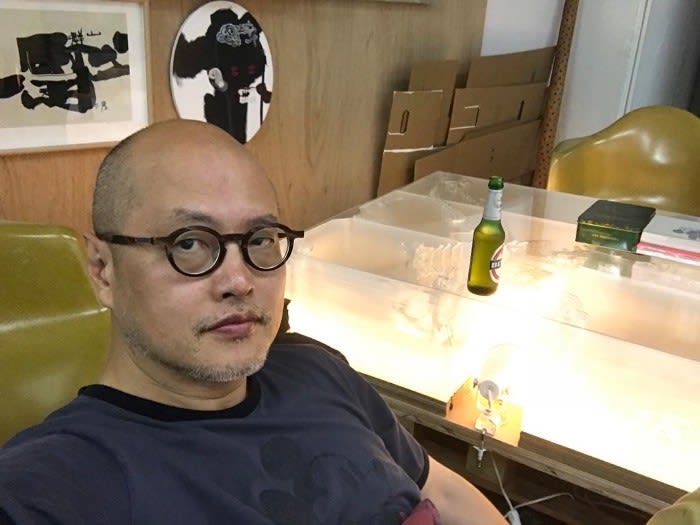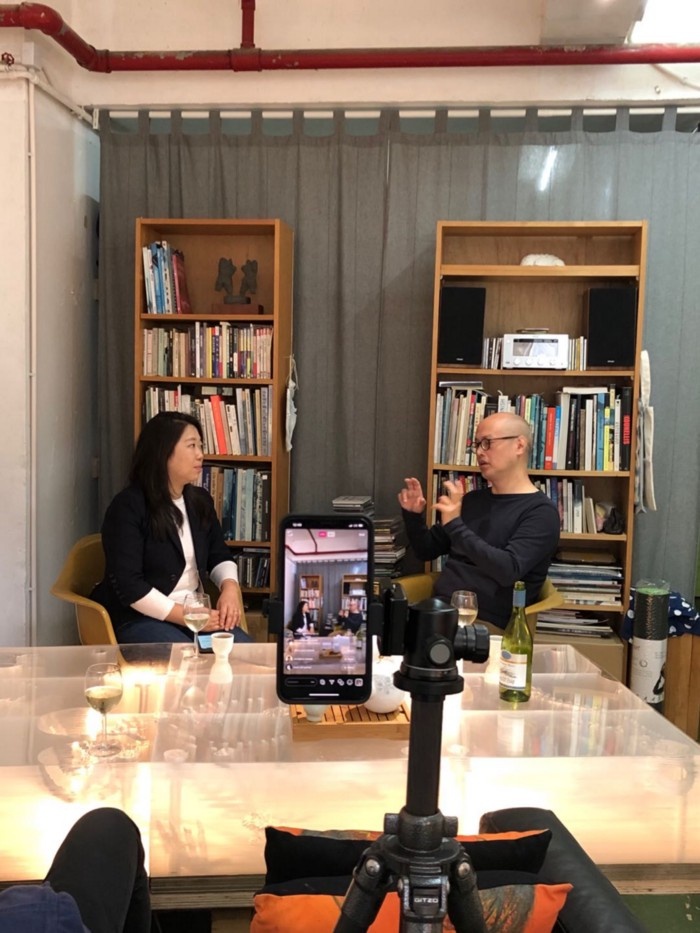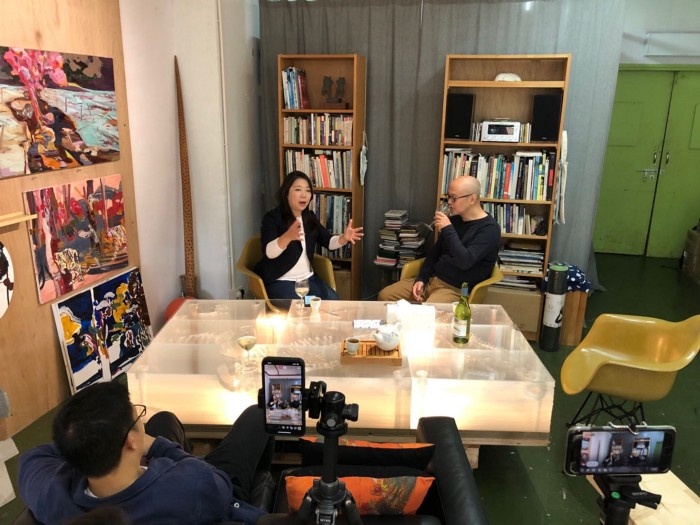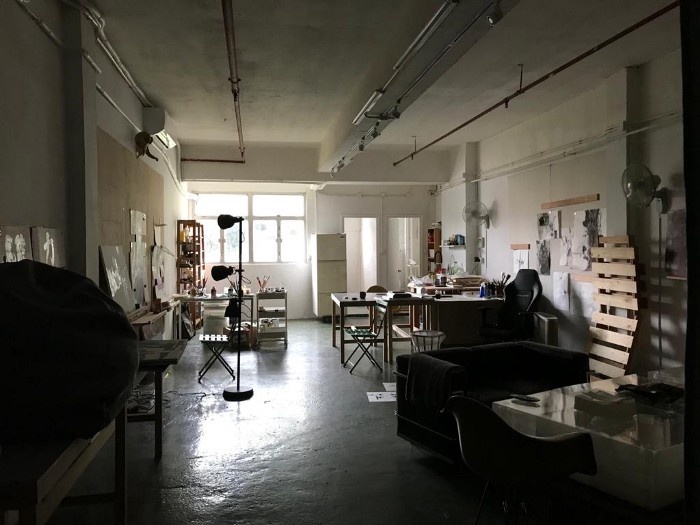
This week, we are pleased to have Hong Kong Art School Acting Director, Professor Kurt Chan, join our discussion on his career in art education and the current circumstances Hong Kong art students are facing now in society.
Dr. Henrietta Tsui-Leung: Tsui-Leung
Kurt Chan: Chan
Tsui-Leung: We are curious to know about your educational background.
Chan: Regarding my education background, I actually entered The Chinese University of Hong Kong in 1979 and it was a very perplexing time. When you think about taking up creative studies, you normally won’t think of fine arts but instead steer towards design. I studied a semester at the First Institute of Art & Design, but I actually wanted to get into The Hong Kong Polytechnic University at that time. The reason why I chose CUHK instead was because they gave me an offer. I often feel that people’s encounters and experiences are not determined by themselves, but by opportunities. So that you can adapt to this opportunity and make use of it. Actually, I wanted to study design, but the fun part is that design school did not accept me, yet art school did. From the first date of studying until graduation, my main question to myself was, “How can I apply what I have learnt?”
When I was in graduate school, I thought of switching to another discipline, back to design. This was because the school I was studying at was really good at design. I always pay attention to how the so-called art or creativity is applied to the world, that is, how it can influence society. If art can’t then design might be the most direct way to achieve this. When I gained more experience and saw more, I also saw how precious art can be.
Tsui-Leung: Why did you choose the United States for your masters?
Chan: In fact, it’s a straightforward idea. I didn’t go to the United States right after graduating and instead I taught a year of secondary school. I’ve seen the bottleneck of Hong Kong’s art education. In the early 1980s, before the birth of the Internet, you weren’t exposed to many foreign things or concepts. However, I saw artists who returned to Hong Kong in the early 80s, for example, Stanley Wong and Antonio Mak Hin-yeung, whose works produced great curiosity. When you want to learn more, if you don’t go to the birthplace of contemporary art and see it yourself, you will never know.

Image: Dr. Henrietta Tsui-Leung and Professor Kurt Chan (image courtesy of Ora-Ora and the artist)
Tsui-Leung: Is it a must for art graduate to go abroad to experience art?
Chan: In fact, you need to see what kind of creation you are engaged in. For example, if you want to participate in the international art world, you will need to be educated abroad. If you want to understand more, I feel there is a need to go in person. In person means not using the Internet to understand, but experiencing art in an authentic way. But the most important thing is to understand the foundation of art, which is not simply an art language or what you see in an art academy. It is what you see in a city and a society, to see what it has experienced before. So, it’s much easier for you to have a contextual understanding of things.
Tsui-Leung: What was the biggest inspiration for you having studied in US?
Chan: It’s about re-examining your own resources through being in a foreign country, because you will feel that you are studying in the United States, but you are not an American. For example, with the so-called avant-garde, you will understand the movement but you didn’t live in that environment, therefore you may not be able to create works in that manner. You don’t have that kind of openness, that kind of criticism, as you aren’t that type of person. Therefore, the most important thing about studying and traveling abroad is to reveal a clearer picture of yourself. What this means is that you can see your weaknesses and your opportunities. So basically, it’s like borrowing a mirror to see yourself.
Tsui-Leung: Did you start teaching right away after your returned?
Chan: My first job after returning to Hong Kong was not as a teacher, but as an art administrator. During this time, I met the most creative people in Hong Kong. I was working in The Hong Kong Institute for Promotion of Chinese Culture. Actually, it was regarded as a leftist organization. At that time, you could see that Deng Xiaoping was beginning to pursue modernism in the mid-80s, which was very different from now. He was trying to reform and open-up, not joking. You could see China changing, the wheel of the era running and things heading to the good side. On the other hand, you also saw a lot of talent, such as Danny Yung and Runfa Ceng, and even some economic talents because I hosted international economic academic conferences. As the institution had various input for different types of programs, I think it broadened my horizon and I met these talented people which opened up my imagination for art, not only limited to visual art.
Tsui-Leung: So how did you end up in education?
Chan: When I completed my undergraduate, the person I admired the most was not an artist, but John Dewey. He is an educator. I don’t know why to be honest. When I was studying I never thought of being a teacher. But after I got into this industry, I started to realize one thing, which I divide into two parts. The first is being brave on your own, while the second is being somebody who has the ability to lead. The latter influenced a lot of people and created many artists, and more artists create even more art. Being brave on your own means to become a great artist on your own. To be honest, there are many conditions to become a great artist. The condition might not be that you are the best or the most talented, but it’s about encounters and opportunities. I would rather focus on the educational aspect and temporarily give up the aura as an artist.
In fact, in studio practice, not many people talk about art from the perspective of a creator, because the type of people who discuss art seems to be art historians or theorists. However, their problem is that they don’t know what happens during the creative process. I always share this responsibility in my role.

Image: Dr. Henrietta Tsui-Leung and Professor Kurt Chan with Artist Halley Cheng (image courtesy of Ora-Ora and the artist)
Tsui-Leung: Is higher education in art important for contemporary artists?
Chan: Art education seems to be a necessary condition nowadays. The main reason is that the discussion and production of art is influenced by an university education. That is, artists in the past ten or twenty years those who have done well, all of them received an university art education. Other disciplines entering the field of art, such as anthropology, psychology, sociology, and philosophy, is also becoming more common. So when you try to understand art, you can’t use a modernist approach where after you see a painting, you simply say whether you like it or not. Because you have to understand what research the artist has done, so the whole process is becoming Intellectualized. If you don’t study I really don’t know how you can create. Not only not knowing how to create, but not knowing how to review your peers’ work. This is one perspective, but another perspective that modernism introduced was, in fact, you don’t really have to learn the so-called art history or art in order to create.
Because they pursued, what I call an animalistic way of creation. In this situation, when you have too much knowledge, you lose your intuition. That is, the balance between knowledge and intuition depends on your education. You need this (knowledge) to participate within the circle of contemporary art. If you don’t mind how the so-called intellectuals see your work and you sincerely want to return to modernism with its directness and instinctive way of creating, you really don’t have to study a lot.
Tsui-Leung: Just like Basquiat?
Chan: Yes, this is because he can determine the value independently, he creates value and creates happiness.
Tsui-Leung: Under the current highly stressful atmosphere in HK and the world, how would you inspire student continue their studies?
Chan: For this question, I don’t think I have the qualifications to answer. Because you know that the current social movement is basically advocated by young people. There are a lot of subtle details within the operation. Besides, how much they care about, and how much these social movements have affected their personal daily lives, I, as a person without personal involvement, find it difficult to make a judgement. Because I have tried to communicate, but I don’t think I am qualified for discussing what they did.
Besides, I feel that as an artist outside of this situation, I have actually started to worry about it. That is, what guidance can I provide to others on how to live? I really don’t know. What I am sure about is that the pressure Hong Kong is facing is actually a state apparatus. It’s very powerful. While the struggle is actually a struggle with people as a unit. No matter whether you have a leader or not, it is still based on people as a unit, but compared to a state apparatus, it’s a system. This is an approach of disparity. I think on social media, there will be fewer and fewer artists that talk about their own creations. Because creating has basically become powerless. If in a relatively dramatic (society), where dramatic things happen every day. For example, there were lots of bloody and brutal actions yesterday, where people are injured to the point of suffering.
It seems that when I was a student, or even now, I believed that art maintained a certain relationship with society to a certain extent. But now I start to think, for example, an artist participates in a social movement and makes a response. Not an artistic response, but directly participating in the social movement as a reaction. Protest in response. In my point of view, nothing is stronger than the changes in the environment we face every day, as well as the so-called brutality. I have been here for decades and I have never seen such a Hong Kong. To see something which is similar to a state of war. And the degree of bleeding needs to be broken hands, that is, to see a physical hand being broken. These images appear in front of the camera. I believe even in movies you might not be able to do this. So logically, what effect does art have?
I fully understand that if a group of students say “I can no longer create”, I understand. But I realise that at least creation is something that works internally. Art is a way to express that I’m not satisfied about something. So, you can use an artistic approach to express. For example, I paint, I do performance art. But how can that compete with a person bleeding in front of you? It can’t. But I think what has been implanted inside, not everybody in Hong Kong can empathize. But artists, as very sensitive individuals, I often feel that they will always find an outlet. If their tool is creation, I will understand that no matter whether the creation is a direct response, like fighting against an event or an escape, a getaway. (I really want to leave, what do you want?) It’s also an expression. That is to say that art has two aspects, one is outward expression, another is self-healing. I think it’s harder to see the healing aspect in social media, but I feel that when a lot of things are happening, it’s not possible to be seen by everyone. Considering art students nowadays, many may have many questions on what is the purpose of art?
I would agree and understand that with the training of artists, there are some ideas being embedded. For example, artists after modernism, art history itself or the way artists think basically lean to the left wing. The meaning of left wing is not to be a leftist, but it’s about sympathizing with the disadvantaged, because the status of an artist has always been considered to be weak.
Because artists are always the most sensitive group of people, I see that there are many artists who have already changed where they are situated or have re-questioned what they have done. To what extent are their works relevant to society? Of course, Hong Kong is a beginner in these types of political events. If you go to Berlin, you will understand. When you look at artworks from Berlin, you will feel discomfort. Because the trauma of this city has strongly influenced its artists and it’s been a long period of time. I’ve begun to understand those works that I have previously felt uncomfortable with. There is a need for this kind of expression. These discomforts are things that a person or artist from a relatively stable city are not able understand. Hong Kong is now having a lesson. I can only think about what art can do in the post-traumatic period. This event will eventually pass, only pass but not in the sense that it will be forgotten. What I mean is that it will stop and people will become tired. What will we do after feeling exhausted? I believe we all have to think about this. Hong Kong art will not rely on the beautiful illusions like the past. It will start to have weight.

Image: Professor Kurt Chan's Studio (image courtesy of Ora-Ora and the artist)
About Ora-Ora Live
Each week, Ora-Ora’s founder Dr. Henrietta Tsui-Leung will speak with various members of the art community — including artists, curators, academics and other professionals working in the cultural sector — to address topics of interest related but not limited to Hong Kong’s art and cultural scene. Arranged in fifteen to thirty-minute segments, the series aims to be an outlet for creativity and a means to connect with peers who share similar interests. The episodes will also available live on Ora-Ora’s Instagram (@galerieoraora), Facebook (Galerie Ora-Ora) and later on Ora-Ora’s YouTube channel.